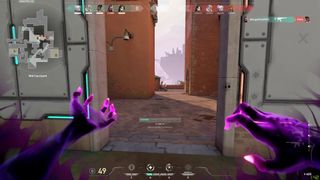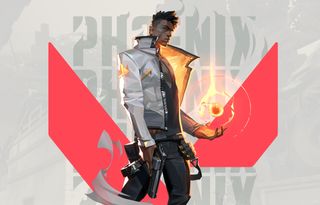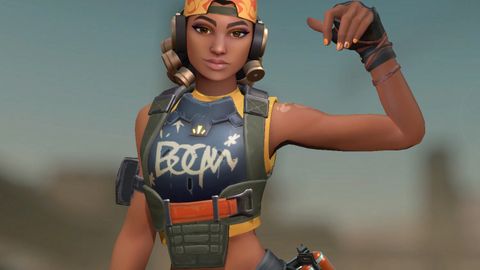Our Verdict
Valorant transforms the best of CS:GO with agents and abilities, resulting in an exceptional FPS that everyone should try.
PC Gamer's got your back
What is it? A Counter-Strike-style FPS from the League of Legends studio
Reviewed on: RTX 2060, Ryzen 5 2600 3.4Ghz, 16 GB RAM
Price: Free-to-play
Release date: Out now
Publisher: Riot Games
Developer: Riot Games
Multiplayer: 5v5 round-based competitive
Link: Official site
It's wild how quickly Valorant has captured the collective consciousness of FPS fans. Riot's competitive shooter is just barely out of beta, yet it already stands toe-to-toe with the biggest games in its genre. It helps that Valorant comes from a gigantic studio and that its deviously smart partnership with Twitch streamers to selectively hand out beta access gave it a running start. But that enormous marketing push wouldn't mean much if Valorant weren't also very good.
It's true that Valorant is Riot's best crack at Counter-Strike, but the ways it remixes Valve’s blueprint are what make it excellent. Anonymous gangs of counter-terrorists are replaced by a cast of vibrant agents with talents that match their personalities. In a very Overwatch fashion, agents quip at each other at the start of rounds and break the fourth wall to announce they've eliminated their "imposter" on the other team (the enemy playing the same character). It has the same upbeat vibe of Overwatch that helps every loss feel a little more friendly.
The 5v5 games take place over up to 25 rounds, which can last anywhere from 10 seconds to a couple minutes each. The attackers want to plant the bomb (called the Spike here) and the defenders have to defuse it or die trying. Other games have borrowed Counter-Strike's round-based bomb mode over the years, but far fewer have ever mimicked Counter-Strike's exact shooting style, map design, and weapon economy. Even in 2020, CS still stands out as a shooter that's won with equal parts mechanical skill, strategic frugality, and deep mind games.

Valorant manages to reproduce those great qualities while tossing magical ice walls and drones into the mix. The deliberate detachment from reality also allows traditional support tools like smoke, flash, and fire grenades to become playful abilities with varied uses. Take Phoenix's Hot Hands, a molotov-style fireball that burns enemies while healing Phoenix, or Jett's Cloudburst, a smoke grenade that she can steer through the air after throwing. It's not only fun to use, but inspires skill shots that aren't possible in Counter-Strike.
Using my camera and Trapwires to tag an enemy and wallbang them through a box is reminiscent of the coolest moments in Rainbow Six Siege.
It's been especially cool to see Sova's recon arrow become its own art form. Practiced players are now consistently landing ridiculous shots across the map that bank off three walls before landing in critical chokepoints, where they detect and mark enemies. Abilities give Valorant a lot of flavor. My main throughout the last two months of closed beta was Cypher, an intel expert who can surveil the map with his sticky camera. Using my camera and Trapwires to tag an enemy and wallbang them through a box is reminiscent of the coolest moments in Rainbow Six Siege.
I love the ways Riot has found to add value to the team beyond clicking on heads, but a few powers don't gel with its lethal combat. The most glaring example is Sage, Valorant's only dedicated support. Even after a few nerfs in the open beta, her ability to heal allies (or herself), cut off choke points with her ice wall, slow enemies, and revive teammates has proven to be an essential part of well-rounded teams. It's clear that she has too many useful tools at once, but my real problem is the dominance of her Resurrection ultimate. Losing a hard-fought round because Sage turned a tense 1v1 into a 1v2 is demoralizing and frustrating. Ultimates are supposed to be influential, but Sage skirts too close to being a round decider. Losing a fight to Valorant's brand new agent, Reyna, is similarly frustrating. Even if I leave her with 20 health, she can quickly slurp up my soul like a spaghetti noodle to overheal up to maximum health. Riot wants to make sure that good aim will always trounce abilities, but I'm not sure that squares with an agent that starts every fight with a clean bill of health.
Striking a balance between Overwatch—where accuracy feels secondary to a well-timed ult—and Counter-Strike's purist weapon jousting is a difficult feat. As Valorant adds more agents over time, any fluctuations on this scale are likely to alienate or agitate players. What's encouraging is how proactive Riot has been about implementing meaningful reworks that nudge the meta in a better direction. The efficiency is a refreshing change of pace from years of playing Rainbow Six Siege, where balancing changes are comparatively slow and often fall short of solving the meta's biggest issues. Of course, this praise will only mean something if Riot can keep it up in the months and years to come.
Aim training
Players who haven't spent triple-digit hours in Counter-Strike might find Valorant's shooting a significant hurdle. Remembering to stand still before shooting is an ongoing adjustment for me, but the practice arena has plenty of useful tools for training your aim and tuning sensitivity. Valorant's exaggerated bullet tracers make it easy to track shots midair and react to recoil on-the-fly. Other intrinsic CS mechanics, like the weapon economy and Buy Phase, feel under-explained. Valorant will undoubtedly attract people who haven't touched CS, and it lacks onboarding for basic strategies like save rounds, playing for picks, and bomb placement.
If you're lucky enough to be matched with friendly players, you may get a gentle introduction. If you're matched with jerks—which are as much a problem here as they are in other competitive games, though Riot does make an effort—the 'advice' you get over voice chat won't necessarily feel helpful. Thankfully, muting is easy and there is a reporting tool. You can also adjust the individual volumes of teammates' microphones, for that annoying teammate who makes callouts but screams every time they die.

The quality-of-life features in Valorant make it clear that Riot took binders of notes while playing CS:GO. The revamped Buy Phase is particularly impressive for CS:GO players. You can effortlessly sell back anything you changed your mind about without any cash penalty. Teammates can easily buy each other weapons without tossing them through the air. Easy shortcuts can instantly let the team know you're saving. An Apex Legends-inspired ping system helps give context to each map's complex web of callouts. Visual pulses on the minimap help players know how far away their footsteps can be heard. I could go on, but just know that Valorant is stuffed with smart conveniences that Valve should absolutely transplant into CS:GO as soon as possible.
Most of Valorant's 16 guns are bland-looking replications of Counter-Strike guns—the M4 becomes the Phantom, AK-47 the Vandal, AWP the Operator, etc—with a few offbeat additions like the Shorty sidearm shotgun.
Unlike CS:GO, every primary can aim-down-sights for a slight zoom and accuracy bonus. That, plus random recoil sway introduced after the first few shots, flies in the face of CS:GO's rigid recoil patterns that can be perfected with practice. It's not just different for the sake of it. Keeping rapid-fire a viable strategy up close while rewarding slower tap-firing at a distance keeps shootouts dynamic and highlights the versatility of assault rifles. Watching someone with a mastery over CS:GO's predictable patterns is a sight to behold, but I prefer the emphasis Valorant places on smart positioning for the weapon you're carrying. Even if it does lower the skill ceiling slightly, we’re still talking about a skyscraper.
Map talk
The only area where Valorant feels a bit shallow at launch is its map pool. There are four maps at launch. It's slim pickings, but I appreciate the variety in layout and style. Riot says it wants each map to feature something "new and unique"—Bind has portals that connect the two sites, Haven's mid is a third bomb site, Split has climbing ropes, and Ascent (the new map for launch) has one-way metal doors.
It’ll take months for the community to fully evaluate each map’s strengths and weaknesses.
For the most part, Valorant's map design succeeds at replicating Counter-Strike's carefully considered sightlines and chokepoints. You can't pick and choose which maps to queue for in matchmaking, so it's all the more important that no maps stand out as completely one-sided. The more gimmicky stuff mostly works, though Split's ropes feel inconsequential and Bind's portals can cause more trouble than they're worth. It'll take months for the community to fully evaluate each map's strengths and weaknesses, but I'm having fun wherever I end up. Having a brand new map to learn has squashed the fatigue I was feeling playing the same three maps during closed beta.
I'd wager that Riot is afraid of overwhelming new players with too many maps. It's a big problem in Siege, which has a rotating pool of 15 maps with complex, multi-level layouts. Starting slow is a smart move, but eventually Ascent will feel old too. If every new season of Valorant will accompany a fresh location, we could see map five in just a few months.

Pay up
Valorant can probably run on a fridge. It isn't anything special visually, but in a competitive game, readability and a high fps are more important than graphical effects.
Riot has also made a big deal about its netcode, and while the adverse effects of lag can't be completely negated, Valorant has largely felt fair to me so far. One thing that helps is simply the number of data centers Riot is working with, as lag compensation is less of an issue when everyone's got a low ping anyway. If Riot keeps its current level of commitment to low-latency matches, Valorant should be one of the better competitive games in that respect.
While Valorant's agents all have distinct visual designs, I can't say the same for the weapons. The default skin for every weapon has the same bland blend of gray, black, and orange. On top of looking boring, it can cause confusion in-game with guns that look too similar from far away. Months in, I'm still grabbing a Phantom off the ground just to find out it's actually a Spectre SMG. To snazz up your loadouts, you'll likely have to dive deep into your wallet.
A few slick skins can be earned in the $10, 50-tier battle pass. Others will need to be bought outright. Some of the skins are neat, but I doubt I'd ever drop $15 to make my Vandal look like a car. Though, I'm tempted by the fancy skins that can be upgraded to modify the reload animations and sounds (there are a few that sound straight outta Mass Effect, so that's cool). Nothing stands out as nickle-and-dimey compared to other free-to-play games, but we're still talking about $70 bundles that have a handful of skins. Grading on a curve or not, that's a ton of money. Thankfully it's easy to ignore the store and just play.
Unlocking agents is another story. Everyone starts with Sage, Phoenix, Jett, Brimstone, and Sova for free. The rest need to be unlocked through Contracts (basically a mini-battle pass for each agent) or bought individually for $10. An early in-game Contract will net you another two agents pretty quickly, but the grind for the last four is significantly slower. The communication on this fact is a bit misleading. It's easy to think you'll be unlocking everyone at the same brisk pace just to hit a brick wall of agent contracts that require magnitudes more experience to finish. Depending on your commitment to completing daily challenges and generally playing a lot, it might take a few weeks or a few months to complete the roster.
Of course, you can always drop the $10 to skip the contract. That's pretty pricey for a hero game. For context, the most expensive League of Legends champions cost around $8. New Rainbow Six Siege operators cost $5 (though the game itself costs $20) and new Apex Legends characters cost $7.50. Skipping the agent contract also gets you small cosmetics like an account banner and "gun buddy" charms that hang from your gun, but it’s still a bit steep.
On guard

Valorant characters: All the hero abilities
Valorant ranks: How you'll be progressing
Valorant system requirements: Can you run it?
Valorant error codes: How to solve them
Valorant tips: Get more wins
Valorant guns: Damage, recoil patterns, and more
For how much I'm loving Valorant, it's hard not to wince a little at Vanguard, Riot's proprietary anti-cheat software required to play the game. Vanguard includes a kernel-mode driver that runs as soon as your PC boots. That means it has unusually high-level access to your PC's innards for the purpose of blocking drivers that cheat programs employ. You can turn it off, but you'll have to restart your machine and let it run the next time you want to launch Valorant. (Correction: We previously stated that Vanguard blocks a program called Core Temp, but an update last month unblocked it, as well as some common RGB and fan controllers.)
Vanguard's deeper roots may make it more effective anti-cheat software, and I've kept it running in the background without much worry, though I question whether it's worth the trouble. Valorant's beta had thousands of confirmed cheaters that Riot eagerly banned. If some cheaters will inevitably bypass Vanguard's fancy safeguards, are players benefiting enough to warrant the intrusion? I'll be interested to see how Riot's war on cheaters plays out. For now, Vanguard is an annoyance that Riot is standing by. I'm trusting them not to blow up my PC.
Valorant is the more accessible Counter-Strike I didn't know I wanted. Abilities add an intoxicating dynamism to every round and expand the scope of teamwork for this style of FPS. I'm genuinely interested to see how new agents and maps keep things fresh in the years to come. Even if unlocking its full roster is a major grind and cosmetics cost a bunch, Valorant is an exceptional team game that you can play right now without spending a dime.
Valorant transforms the best of CS:GO with agents and abilities, resulting in an exceptional FPS that everyone should try.

Morgan has been writing for PC Gamer since 2018, first as a freelancer and currently as a staff writer. He has also appeared on Polygon, Kotaku, Fanbyte, and PCGamesN. Before freelancing, he spent most of high school and all of college writing at small gaming sites that didn't pay him. He's very happy to have a real job now. Morgan is a beat writer following the latest and greatest shooters and the communities that play them. He also writes general news, reviews, features, the occasional guide, and bad jokes in Slack. Twist his arm, and he'll even write about a boring strategy game. Please don't, though.
